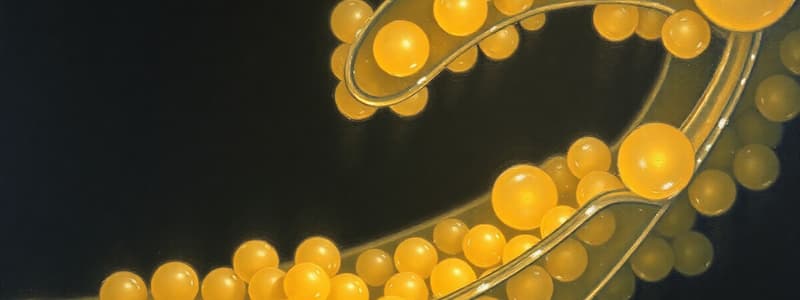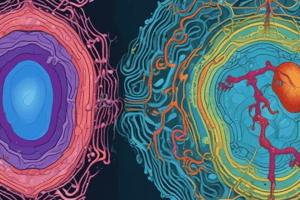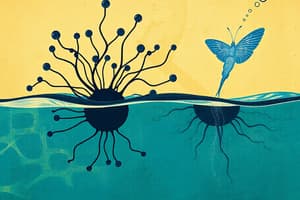Podcast
Questions and Answers
What role do cofactors play in enzyme activity?
What role do cofactors play in enzyme activity?
- They are proteins that enhance enzyme stability.
- They serve as substrates for enzyme reactions.
- They bind to the active site and assist in catalysis. (correct)
- They are waste products produced during enzymatic reactions.
Which of the following statements about enzyme inhibitors is true?
Which of the following statements about enzyme inhibitors is true?
- Non-competitive inhibitors bind only to the enzyme-substrate complex.
- Competitive inhibitors can be overcome by reduced substrate concentration.
- Competitive inhibitors mimic the substrate and compete for the active site. (correct)
- All inhibitors decrease the affinity of the enzyme for its substrate.
How does a cell regulate its enzymatic activity?
How does a cell regulate its enzymatic activity?
- By permanently inhibiting all enzyme activity in the cell.
- By simultaneously activating all metabolic pathways.
- By turning the genes on or off that encode for specific enzymes. (correct)
- Through uncontrolled genetic expression of enzymes.
What is the significance of coenzymes in relation to vitamins?
What is the significance of coenzymes in relation to vitamins?
What defines a competitive inhibitor in enzyme activity?
What defines a competitive inhibitor in enzyme activity?
What type of energy involves the motion of objects performing work?
What type of energy involves the motion of objects performing work?
Which form of energy is primarily utilized by cells to perform work?
Which form of energy is primarily utilized by cells to perform work?
What is described as energy transformation occurring in a collection of matter?
What is described as energy transformation occurring in a collection of matter?
According to the first law of thermodynamics, what is true about energy in the universe?
According to the first law of thermodynamics, what is true about energy in the universe?
Which type of energy is associated with the random movement of atoms or molecules?
Which type of energy is associated with the random movement of atoms or molecules?
What form of potential energy is possessed by molecules because of their atomic structure?
What form of potential energy is possessed by molecules because of their atomic structure?
An organism's exchange of energy and matter with its environment characterizes it as what type of system?
An organism's exchange of energy and matter with its environment characterizes it as what type of system?
What type of energy can be harnessed during processes like photosynthesis?
What type of energy can be harnessed during processes like photosynthesis?
What role do aquaporins play in a cell's membrane?
What role do aquaporins play in a cell's membrane?
Which statement about the phospholipid bilayer is correct?
Which statement about the phospholipid bilayer is correct?
What can happen if kidney cells produce too many aquaporins?
What can happen if kidney cells produce too many aquaporins?
How do water molecules primarily travel through the cell membrane?
How do water molecules primarily travel through the cell membrane?
What is the primary consequence of plasmolysis in plant cells?
What is the primary consequence of plasmolysis in plant cells?
How do transport proteins assist polar molecules in crossing cell membranes?
How do transport proteins assist polar molecules in crossing cell membranes?
What is a potential consequence of defective aquaporins in individuals?
What is a potential consequence of defective aquaporins in individuals?
What was the unexpected discovery made by Peter Agre's research team?
What was the unexpected discovery made by Peter Agre's research team?
What type of transport is facilitated diffusion classified as?
What type of transport is facilitated diffusion classified as?
Which describes the significance of the fluid mosaic model in relation to cell membranes?
Which describes the significance of the fluid mosaic model in relation to cell membranes?
What is the primary composition of the lipid bilayer in a cell membrane?
What is the primary composition of the lipid bilayer in a cell membrane?
What characterizes aquaporins in the context of cell membranes?
What characterizes aquaporins in the context of cell membranes?
What method did Dr. Agre's team use to identify the smaller protein in their sample?
What method did Dr. Agre's team use to identify the smaller protein in their sample?
What might increase the synthesis of aquaporin proteins in certain cells?
What might increase the synthesis of aquaporin proteins in certain cells?
What significant role does the newly discovered protein play in kidney cells?
What significant role does the newly discovered protein play in kidney cells?
What happens to food-spoiling bacteria in concentrated salt solutions?
What happens to food-spoiling bacteria in concentrated salt solutions?
Which substance is most likely to utilize facilitated diffusion to cross cell membranes?
Which substance is most likely to utilize facilitated diffusion to cross cell membranes?
Which experimental condition was used to test the hypothesis about the new protein's function?
Which experimental condition was used to test the hypothesis about the new protein's function?
What phenomenon was observed in the RNA-injected frog eggs when subjected to a hypotonic solution?
What phenomenon was observed in the RNA-injected frog eggs when subjected to a hypotonic solution?
Why is plasmolysis particularly lethal to plant cells?
Why is plasmolysis particularly lethal to plant cells?
In terms of water balance, how does the contractile vacuole function in freshwater Paramecium?
In terms of water balance, how does the contractile vacuole function in freshwater Paramecium?
Which cells were found to express the newly discovered protein more abundantly than red blood cells?
Which cells were found to express the newly discovered protein more abundantly than red blood cells?
What conclusion did the researchers reach regarding the smaller protein after initial tests?
What conclusion did the researchers reach regarding the smaller protein after initial tests?
Why did Dr. Agre's team initially believe the smaller protein was a breakdown product?
Why did Dr. Agre's team initially believe the smaller protein was a breakdown product?
Which statement best describes the function of cellular respiration in relation to energy?
Which statement best describes the function of cellular respiration in relation to energy?
How do endergonic reactions differ from exergonic reactions?
How do endergonic reactions differ from exergonic reactions?
What does the second law of thermodynamics imply about the process of diffusion across a membrane?
What does the second law of thermodynamics imply about the process of diffusion across a membrane?
Which of the following accurately describes an exergonic reaction?
Which of the following accurately describes an exergonic reaction?
In the context of cellular reactions, what is the significance of storing energy as ATP?
In the context of cellular reactions, what is the significance of storing energy as ATP?
What type of reaction is photosynthesis classified as?
What type of reaction is photosynthesis classified as?
Why is burning wood considered an exergonic reaction?
Why is burning wood considered an exergonic reaction?
What role does entropy play in the context of living cells?
What role does entropy play in the context of living cells?
Flashcards
Cofactor
Cofactor
A nonprotein helper molecule that binds to an enzyme's active site and aids in catalysis.
Coenzyme
Coenzyme
An organic cofactor.
Inhibitor
Inhibitor
A chemical that interferes with an enzyme's activity.
Competitive inhibitor
Competitive inhibitor
Signup and view all the flashcards
Noncompetitive inhibitor
Noncompetitive inhibitor
Signup and view all the flashcards
Transport Protein
Transport Protein
Signup and view all the flashcards
Energy
Energy
Signup and view all the flashcards
Kinetic Energy
Kinetic Energy
Signup and view all the flashcards
Aquaporins
Aquaporins
Signup and view all the flashcards
Osmotic Swelling
Osmotic Swelling
Signup and view all the flashcards
Potential Energy
Potential Energy
Signup and view all the flashcards
Hypotonic Solution
Hypotonic Solution
Signup and view all the flashcards
Chemical Energy
Chemical Energy
Signup and view all the flashcards
Messenger RNA (mRNA)
Messenger RNA (mRNA)
Signup and view all the flashcards
Thermodynamics
Thermodynamics
Signup and view all the flashcards
Translation
Translation
Signup and view all the flashcards
Law of Energy Conservation
Law of Energy Conservation
Signup and view all the flashcards
Plasma Membrane
Plasma Membrane
Signup and view all the flashcards
Open System
Open System
Signup and view all the flashcards
Selective Permeability
Selective Permeability
Signup and view all the flashcards
Exocytosis
Exocytosis
Signup and view all the flashcards
Exergonic Reactions
Exergonic Reactions
Signup and view all the flashcards
Osmosis
Osmosis
Signup and view all the flashcards
Endergonic Reactions
Endergonic Reactions
Signup and view all the flashcards
ATP (Adenosine Triphosphate)
ATP (Adenosine Triphosphate)
Signup and view all the flashcards
Plasmolysis
Plasmolysis
Signup and view all the flashcards
Cellular Respiration
Cellular Respiration
Signup and view all the flashcards
Photosynthesis
Photosynthesis
Signup and view all the flashcards
Facilitated Diffusion
Facilitated Diffusion
Signup and view all the flashcards
Active Transport
Active Transport
Signup and view all the flashcards
Entropy
Entropy
Signup and view all the flashcards
Diffusion
Diffusion
Signup and view all the flashcards
Fluid Mosaic Model
Fluid Mosaic Model
Signup and view all the flashcards
Phospholipids
Phospholipids
Signup and view all the flashcards
Membrane Proteins
Membrane Proteins
Signup and view all the flashcards
Homeostasis
Homeostasis
Signup and view all the flashcards
Importance of Homeostasis
Importance of Homeostasis
Signup and view all the flashcards
Study Notes
The Working Cell
-
Cells have a membrane that allows water to flow across.
-
This membrane is a lipid bilayer made of phospholipids.
-
The heads of the phospholipids are hydrophilic (water-loving).
-
The tails of the phospholipids are hydrophobic (water-fearing).
-
Membrane proteins called aquaporins form water channels.
-
Aquaporins allow billions of water molecules to flow through the membrane every second, far more than can travel through the lipid bilayer on their own.
-
Aquaporins are essential for water balance, like in the kidneys
-
Some people have defective aquaporins which leads to drinking 20 liters of water per day to prevent dehydration.
-
Membranes are fluid mosaics of lipids and proteins.
-
A cell membrane's structure enables many functions such as regulating transport across the membrane.
-
Some membrane proteins are enzymes.
-
Membrane proteins may form intercellular junctions that attach adjacent cells.
-
Some proteins attach to the ECM and cytoskeleton helping support the membrane and coordinate internal / external changes.
-
Membrane proteins can form intercellular junctions, regulate traffic across the membrane, and perform other functions.
-
A cell's metabolic reactions transform energy, using ATP to drive cellular work.
-
Enzymes speed up a cell's chemical reactions and provide precise control of metabolism.
-
The spontaneous formation of membranes was critical for the origin of life.
-
Substances like phospholipids can spontaneously self-assemble into simple membranes.
-
Membranes allow chemical differences and regulate chemical exchanges with the environment.
-
Passive transport is diffusion across a membrane without energy.
-
Diffusion is the tendency of particles to spread out into available space.
-
Passive transport across the membrane occurs through concentration gradients.
-
Oxygen (O2) and carbon dioxide (CO2) easily diffuse across cell membranes.
-
Osmosis is the diffusion of water across a membrane.
-
Tonicity refers to the ability of a surrounding solution to cause a cell to gain or lose water.
-
Isotonic solutions have equal solute concentration inside and outside the cell.
-
Hypotonic solutions have lower solute concentrations than inside the cell.
-
Hypertonic solutions have higher solute concentrations than inside the cell.
-
Cells in a hypotonic solution gain water, swell and may burst.
-
Cells in a hypertonic solution lose water and shrink.
-
Transport proteins facilitate diffusion across membranes.
-
Hydrophilic substances use transport proteins to cross hydrophobic layers.
-
Transport proteins speed up water transport.
-
Transport proteins are essential for regulating water transport in various cell types.
-
Cells expend energy in active transport of a solute.
-
Active transport moves solutes against their concentration gradient, requiring energy (ATP).
-
Transport proteins are essential for active transport.
-
Active transport is vital for maintaining internal conditions different from the surroundings (e.g., K+ and Na+ in animal cells)
-
Exocytosis and endocytosis transport large molecules.
-
Exocytosis moves large molecules out of the cell using vesicles.
-
Endocytosis moves large molecules into the cell using vesicles
-
Phagocytosis is a type of endocytosis involving engulfing large particles.
-
Receptor-mediated endocytosis takes in specific molecules using specific receptors.
-
Cells transform energy as they perform work.
-
Kinetic energy is energy of motion.
-
Potential energy is stored energy.
-
Chemical energy is stored in molecular bonds.
-
Thermal energy is random atomic / molecular movement (heat).
-
The first law of thermodynamics states that energy cannot be created nor destroyed.
-
The second law of thermodynamics states that energy transfers increase entropy (disorder) of the surrounding.
-
Enzymes speed up reactions by lowering activation energy.
-
Enzymes have specific shapes and fit substrates in a region called the active site.
-
The activation energy barrier protects ordered molecules from breaking down spontaneously.
-
Heat speeds up molecules and reactions.
-
Enzyme inhibition regulates enzymatic activity.
-
Inhibitors can be competitive (blocking the active site), or non-competitive (inhibiting the enzyme in another part).
-
Feedback inhibition is a regulatory mechanism where the product of a reaction inhibits an enzyme earlier in the pathway.
-
Many drugs, pesticides, and poisons are enzyme inhibitors.
-
Inhibitors interfere with enzyme function, either reversibly or irreversibly.
Studying That Suits You
Use AI to generate personalized quizzes and flashcards to suit your learning preferences.




